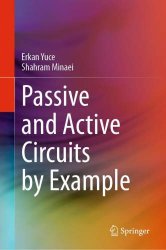Passive and Active Circuits by Example
- Добавил: literator
- Дата: 9-11-2023, 08:16
- Комментариев: 0
 Название: Passive and Active Circuits by Example
Название: Passive and Active Circuits by ExampleАвтор: Erkan Yuce, Shahram Minaei
Издательство: Springer
Год: 2024
Страниц: 265
Язык: английский
Формат: pdf (true), epub
Размер: 30.6 MB
This book enables readers to become familiar with passive and active realizations of the impedances and important filter transfer functions (TFs). Firstly, time, s, and frequency domain analysis of the R-L, R-C, and R-L-C circuits are discussed. Then, active realizations of the impedances and TFs using different active devices are introduced. Readers will benefit from an example-driven approach to topics such as operational amplifiers, current followers, voltage followers, unity gain inverting amplifiers, negative impedance converters, first-generation current conveyors, second-generation current conveyors, third-generation current conveyors, differential voltage current conveyors, etc. will be introduced, which will be accompanied with a number of examples. Non-ideal gain effects on the performance of the active circuits are also demonstrated.
In the past three decades, research and development of active building blocks have been rapidly increased. While operational amplifier-based circuits still find nice applications, new active elements derived from concept of current conveyors have emerged as alternatives for designing active filters, simulated inductors, etc.
This book deals with analysis and design of different types of active filters, simulated inductors, etc. through giving more than 200 examples.
The text comprises nine chapters that are chosen to provide a complete source for the researchers, undergraduate students, and graduate students who are working on the applications and designs of active filters, simulated inductors, oscillators, rectifiers, etc. with new active elements.
Chapter 1 introduces basic concepts such as symbols, units, and prefixes. Several fundamental functions such as constant, sine wave, full-wave rectified, positive half-wave rectified, square wave, triangular wave, sawtooth wave, exponential, delta, unit step, and unit ramp functions versus time are given, where 1 MHz frequency is taken for all the periodical signals. Sensitivity analysis with three examples are treated in which an arbitrary function, an RLC circuit, and two bipolar junction transistor (BJT)-based structures are used.
Chapter 2 treats analog signals and systems. The concepts involving linearity, non-linearity, time-invariant, time-variant, linear time-invariant, and causality are briefly explained. Total harmonic distortion is defined, which is explained with an NMOS transistor-based simple amplifier. Definitions of Laplace and Fourier transforms are given. Ideal, second-order ideal, and first-order ideal transfer functions are discussed in detail.
Chapter 3 investigates the basic passive elements, resistor, capacitor, and inductor. Current and voltage relations of these passive elements in the time domain, s domain, and frequency domain are also given. Phase and magnitude of any impedance are explained by means of many practices. Fundamental RC and RL circuits and their operating frequency ranges are given. Parallel and/or series RLC circuits are analyzed with some examples. Time domain, s domain, and frequency domain analyses for the series and parallel RC, RL, and RLC circuits are given with some examples. Quality factors of the series and parallel RC, RL, and RLC circuits are explained. Numerous SPICE simulation results are also included to explain the given circuits in which ideal elements are used.
...
Chapter 9 introduces other important active components, namely current feedback operational amplifier, operational transresistance amplifier, four-terminal floating nullor, operational transconductance amplifier, voltage differencing inverting buffered amplifier, voltage differencing buffer amplifier, current differencing buffered amplifier, current amplifier, current follower transconductance amplifier, current differencing transconductance amplifier, differential voltage current conveyor transconductance amplifier, and current operational amplifier. Simulated inductors are generally given as application examples for these active devices.
Скачать Passive and Active Circuits by Example
Внимание
Уважаемый посетитель, Вы зашли на сайт как незарегистрированный пользователь.
Мы рекомендуем Вам зарегистрироваться либо войти на сайт под своим именем.
Уважаемый посетитель, Вы зашли на сайт как незарегистрированный пользователь.
Мы рекомендуем Вам зарегистрироваться либо войти на сайт под своим именем.
Информация
Посетители, находящиеся в группе Гости, не могут оставлять комментарии к данной публикации.
Посетители, находящиеся в группе Гости, не могут оставлять комментарии к данной публикации.
